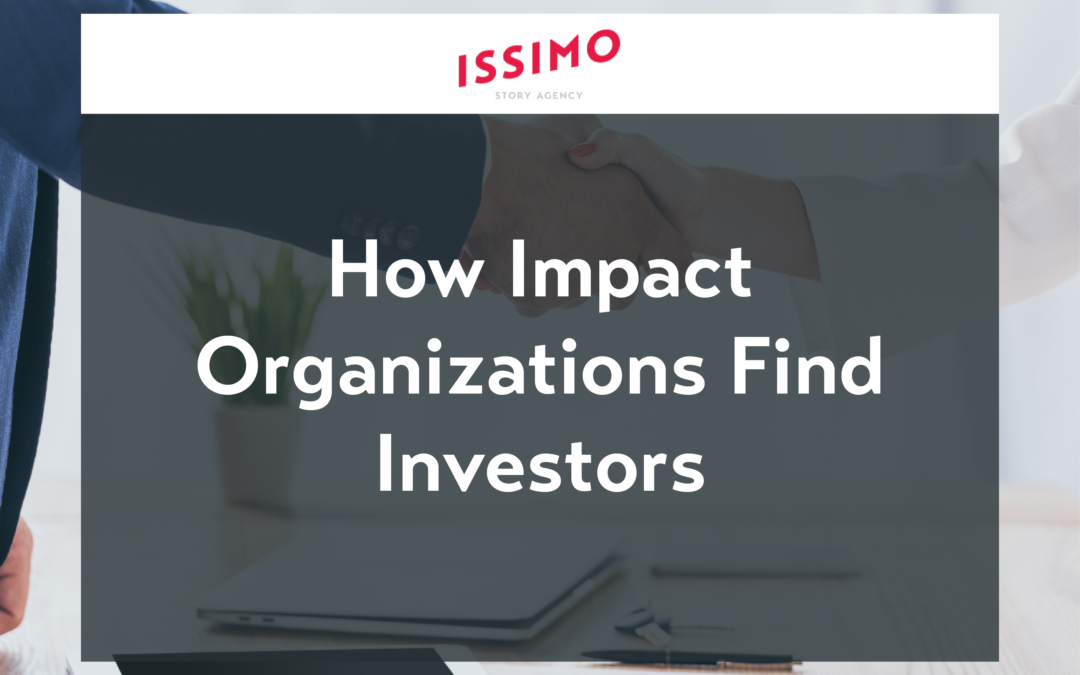Finding Investors for Impact Fundraising
We recently conducted an attitudinal research study to learn more about the state of impact fundraising. In our first blog, we shared the three attitudinal segments that emerged—Confident, Aspiring, and Struggling respondents—plus criteria for determining which one resonates with your situation (to make sure this blog is more useful, check out that one first).
We explored how impact organizations raise funds and the role fundraising events play in our second blog. Finally, our third blog discussed how the COVID-19 pandemic affected impact organizations, especially fundraising efforts and access to investors, and how people feel about their industry’s future outlook. Today’s post will reveal the research on how these professionals find investors.
The First Step to Make an Impact
Storytelling is about influence and persuasion. But when it comes to the most important audience to influence, impact organizations say it’s investors and donors. That’s partially because nothing can happen until an organization has the funds to start making an impact. Here are the top three ways respondents are finding investors for impact fundraising:
- 69 percent use their senior leadership’s network
- 50 percent research investors who have funded organizations similar to theirs
- 36 percent meet attendees at conferences
Here’s what we learned from finding investors for impact fundraising.
Relationships Matter
Don’t underestimate the importance of your personal network in finding investors for impact fundraising because as our research showed, relationship capital leads to financial capital. Even though technology keeps evolving, we as humans are still hardwired for in-person connection. And how well connected you are could be exponentially more important than you realize.
Researchers at Columbia University discovered that how connected you are follows a power law distribution where there are few highly connected people and it drops off quickly. If you think about how this relates to the Pareto principle, or the 80/20 rule, then 20 percent of people have 80 percent of the connections to investors and donors. Therefore, having the right people on your team should also include someone that is highly connected.
Anyone can build a strong network that can connect them to the right investors and donors. Here are steps that can help:
#1: Make the Investment
Building relationships takes time because it’s a long yet lucrative game. You want to put in the effort before you need something. You also want to give more to the relationship than you take (being extractive and transactional depletes relationship capital).
#2: Diversify
Don’t keep all your eggs in one basket. Having an amazing connection to one large family office might be great, but what happens if that door closes? You want to nurture relationships with different groups that don’t normally connect so innovation can thrive
#3: Let the Snowball Effect Happen
When you invest in your network, it creates a snowball effect. The more people you have in your network, the more that it’ll become desirable and attract even more people.
However, it’s not just about how many people you know. It’s about how many people know and trust you. Thought leadership is a way to expand your team’s influence beyond their personal network. Do this by:
- Sharing your expertise combined with your unique perspective through places like podcasts, a video series or written articles. What insights do you have that are sought after and beneficial for your audience?
- Leveraging endorsement and third-party validation. Say “yes” when you’re invited to speak at an event or be a guest on a podcast. Things like this will help build your credibility as an expert that will help investors and donors extend trust.
61 percent of our research respondents say a representative from their organization speaks at fundraising conferences at least sometimes. Struggling respondents were the least likely to speak while Confident respondents were the most likely.
64 percent say being recognized as a thought leader increases their fundraising effort’s success, more than strong financial returns, strong fundraising track records, having a charismatic founder, or affiliations with celebrities.
Look-Alikes Are Worth Looking Into
Our research discovered that half of impact fundraisers find investors and donors by researching people who have funded organizations that are similar to theirs.
People like to invest in things they know. By looking for those who invest in similar companies, you are honing in on those who have already shown a willingness to contribute to your cause. Unfamiliar industries have different risks that can turn off investors.
But where do you find that information? Our research discovered that 72 percent of respondents rely on an in-house fundraising or business development team versus using online databases or proprietary tools.
Our research discovered that half of impact fundraisers find investors and donors by researching people who have funded organizations that are similar to theirs.
People like to invest in things they know. By looking for those who invest in similar companies, you are honing in on those who have already shown a willingness to contribute to your cause. Unfamiliar industries have different risks that can turn off investors.
But where do you find that information? Our research discovered that 72 percent of respondents rely on an in-house fundraising or business development team versus using online databases or proprietary tools.
Conferences Build Connections
Although less than personal relationships and researching similar organizations, more than one-third of those finding investors for impact fundraising use conferences to network.
Events are still relevant for building personal networks and connecting with potential investors and donors:
- 26 percent of respondents say someone from their organization attends The Global Impact Investor Network.
- 22 percent say someone from their organization attends Social Capital Network events.
- 32 percent say their organization sometimes sponsors conferences or events. However, about one-half say their organization is rarely or never a sponsor.
When we look at the top responses, we see a clear trend toward the human element in fundraising. It’s about the people you know and the people you can connect with. There’s wisdom in this widely attributed quote, “The best time to plant a tree was 30 years ago. The second best time to plant a tree is now.”
Even though it’s best to already have a strong network of potential investors and donors, it’s still never too late to start building that community.
To learn more about each segments’ behaviors and the opportunities they present, check out our entire executive summary. And to explore the data yourself, check it out here.

